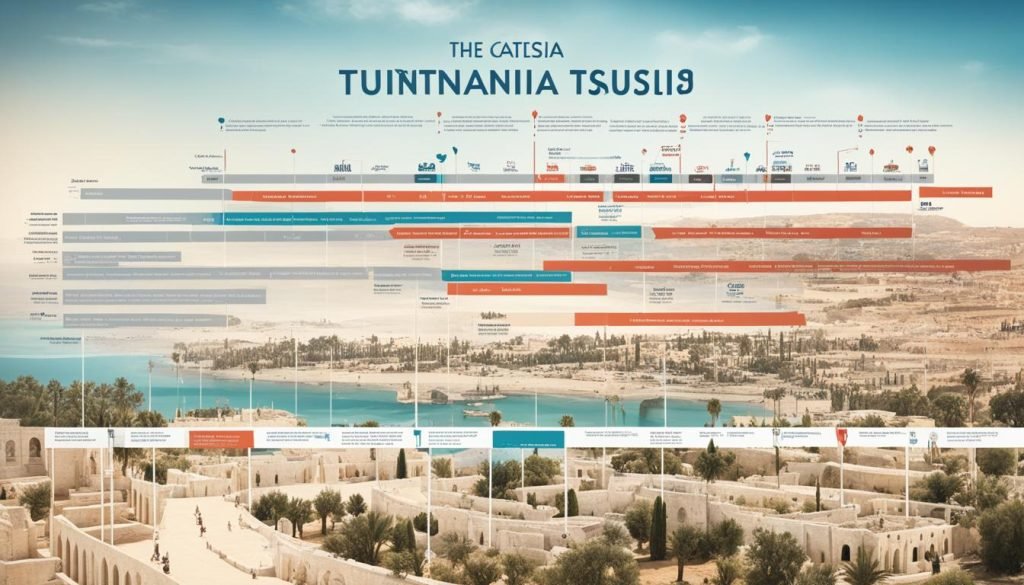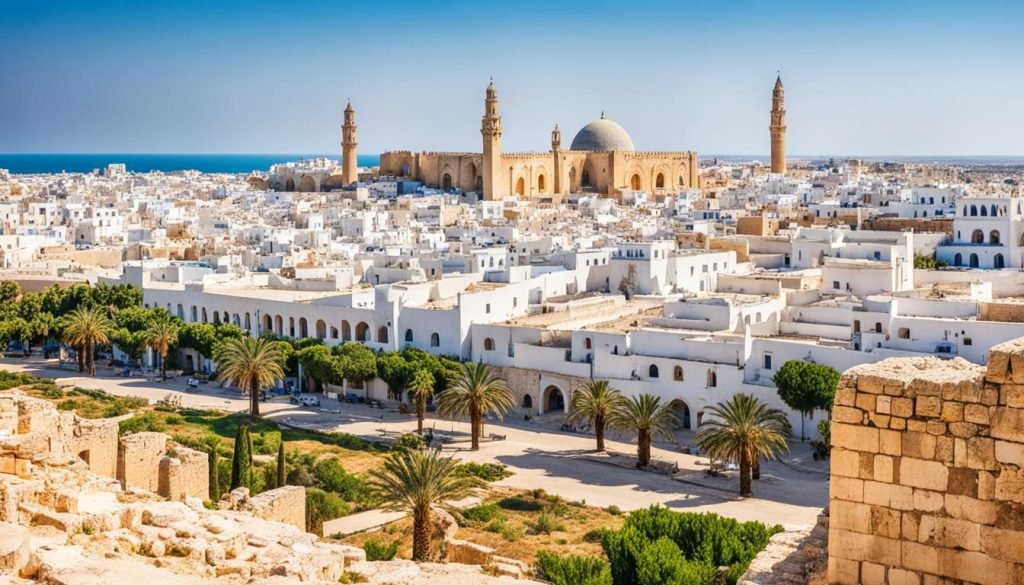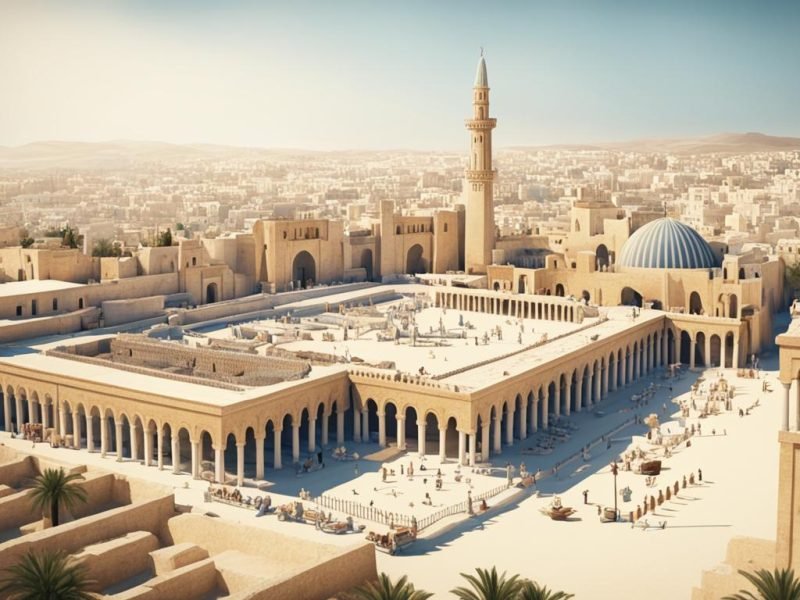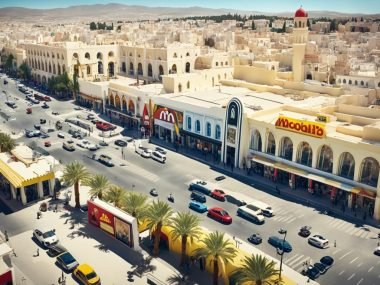Did you know Tunisia has a long history that goes back over 2,800 years? It started with the ancient city of Carthage in 814 BC. Tunisia is by Algeria, Libya, and the sea. Many empires, like the Romans and Arabs, have ruled it.
Tunisia became its own country on March 20, 1956. It changed from a kingdom to a republic on July 25, 1957. Now, Tunisia is a semi-presidential republic. It got a new constitution on July 25, 2022.
Key Takeaways
- Tunisia’s history dates back to the founding of Carthage in 814 BC.
- The modern state of Tunisia was established on March 20, 1956.
- Tunisia transitioned to a Republic on July 25, 1957.
- The country has been influenced by Roman, Arab-Muslim, Ottoman, and French rule.
- Tunisia most recently updated its constitution on July 25, 2022.
Introduction to Tunisia’s Age
Tunisia’s history is long and fascinating. It includes the founding of Carthage in 814 BC and gaining independence in 1956. This timeline points to a land lived in since ancient times. First by Berber tribes, then Phoenician settlers. This depth of history has seen influence from Romans, Arab-Muslims, and the French.
The country’s past goes through many periods, adding to its rich story. Berbers were the first to live there. Then came the Phoenicians, who set up Carthage. This city was key in trade and culture long ago.
Carthage was a powerhouse in the Mediterranean. It competed with Rome before being conquered.
Roman rule brought lasting changes to Tunisia like buildings and laws. This was followed by the Arab-Muslim conquest in the 7th century. It brought in Islam and Arab culture. Then, French colonial rule started in 1881. It changed Tunisia’s society and economy a lot, sparking movements for independence.
From these historic events, modern Tunisia was born. It mixes its varied history into what it is now. Understanding where Tunisia comes from shows the depth and strength of its nation today.
How Old Is The Country Tunisia?
Tunisia has a long history, starting around 814 BC. This was when Phoenicians founded Carthage. It’s a key time in Tunisia’s history. Since then, many rulers have controlled Tunisia, like the Romans and Arabs. By 1956, Tunisia became independent.
Tunisia’s story is full of different chapters. It started with Carthage, then the Romans came in 146 BC. They left a big mark. The Arab Muslims came in the 7th century, changing its culture. The Ottoman Empire took over in the 16th century, adding to Tunisia’s story. The French ruled in the late 1800s, leading to Tunisia’s independence.
A chart below shows Tunisia’s main historical events. It helps us see Tunisia’s age through various important times:
| Epoch | Significance | Time Period |
|---|---|---|
| Founding of Carthage | First significant establishment | 814 BC |
| Roman Conquest | Colonial expansion and transformation | 146 BC – 439 AD |
| Arab-Muslim Conquest | Introduction of Islam and Arab culture | 7th century |
| Ottoman Era | Administrative and cultural influences | 16th century – 1881 |
| French Protectorate | Colonial rule leading to modern statehood | 1881 – 1956 |
| Independence | Formation of modern Tunisia | 1956 – present |
So, Tunisia’s age shows a long and complex history. It went through many eras. Each one added to its rich culture.
Origins of Tunisia: From Ancient Carthage
Tunisia started with Carthage, set up by Phoenician settlers in 814 BC. This city became a big trade and military power, challenging Rome. It was the mix of Phoenician and early Berber people that gave Tunisia its rich cultural start.
The Founding of Carthage
Carthage’s founding was key for Tunisia. Skilled Phoenician sailors made it a big trade spot. It grew to lead in the Mediterranean, shaping economy and politics around it.
Early Civilisations and Settlements
The start in Tunisia was with Berber tribes. They built early social and cultural foundations. Then, Phoenicians joined, creating the Punic culture. This mix made Tunisia’s heritage rich and complex.
| Key Aspects | Details |
|---|---|
| Founding Date | 814 BC |
| Primary Settlers | Phoenicians |
| Early Tribes | Berber tribes |
| Cultural Integration | Punic culture |
| Main Activities | Trade and Commerce |
Tunisia through the Roman Empire
The Roman Empire started in Tunisia after they won over Carthage in 146 BC. This time brought a lot of Roman culture to Tunisia. You can see their mark in the amazing old buildings that remain.
Roman Conquest and Influence
After beating Carthage, the Romans made Tunisia a part of their territory. They called it Africa Proconsularis. The mix of Roman and local ways created a new, mixed culture. Roman building projects and systems made the area more important.
Architectural Legacies Left Behind
The Romans left behind great buildings in Tunisia. These show off their skill in building and designing cities. The Amphitheatre of El Jem is as impressive as Rome’s Colosseum.
There are also beautiful floor pictures made from tiny pieces of coloured stones. Plus, old cities like Dougga and Carthage have amazing remains of temples and baths.
| Roman Architectural Sites | Significance |
|---|---|
| Amphitheatre of El Jem | A massive structure used for entertainment, showcasing Roman engineering prowess. |
| Dougga | An ancient city with well-preserved ruins, providing insights into Roman urban planning. |
| Carthage | Features remnants of Roman baths, temples, and houses, illustrating the city’s importance. |
| Mosaic Works | Intricate artworks adorning public and private buildings, reflecting cultural and daily life. |
These old Roman buildings in Tunisia teach us a lot. They show how advanced the Romans were. They also tell us about history and culture.
The Arab-Muslim Conquest
The Arab-Muslim arrival in the 7th century changed Tunisia’s history deeply. Arab Muslims met initial pushback but soon merged their culture with the locals.
Arrival of the Arab Muslims
Arab Muslims started coming to Tunisia around 670 AD. This was under the Umayyad Caliphate’s rule. Their coming started big cultural and religious changes in the area. They faced tough fights from the Berber tribes but eventually made their home there.
Establishment of Arab Culture and Islam
After their conquest, Islam’s spread began changing Tunisia. Arab culture and local ways melded together. This mix created a special cultural blend.
This era made Arabic the main language and Islam very important in daily life. Arabs brought new building styles and city designs, showing Islamic beauty.
The Ottoman Era in Tunisia
The 16th century brought big changes to Tunisia. It was the start of the Ottoman era there. The Ottomans took over Tunisia in 1574, adding it to their big territory. Their impact changed how Tunisia was governed, its society, and culture deeply.
Ottoman Control and Administration
Ottomans changed Tunisia’s politics by introducing new ways to govern. They set up a local government led by Beys. These Beys kept order and made sure laws were followed. This new system brought stability. It also mixed Ottoman traditions with Tunisian ways of life.
Impact of Ottoman Rule on Tunisian Society
The Ottomans affected many parts of Tunisian life. They brought in new building styles that mixed with the old. This created beautiful, unique buildings. They also changed the food by adding Turkish tastes. These changes made Tunisia’s culture richer. They still influence Tunisia today.
| Aspect | Pre-Ottoman Tunisia | Ottoman Tunisia |
|---|---|---|
| Political Governance | Fragmented Berber Kingdoms | Centralised under Beys |
| Architecture | Roman-Phoenician influences | Turkish-Ottoman designs |
| Cuisine | Berber and Roman dishes | Turkish flavours combined with local ingredients |
| Social Customs | Indigenous Berber customs | Integration of Ottoman traditions |
The Ottoman era lasted over three centuries in Tunisia. It was a time of big changes. These changes added new layers to Tunisia’s rich history. The influence of the Ottomans can still be seen in Tunisia today, in its society and culture.
French Colonisation of Tunisia
The French set up a protectorate in Tunisia in 1881. This changed Tunisia in many ways. It brought new roads, railways, and cities. But, it also led to Tunisia losing some of its wealth and identity.
The French rule changed how Tunisia was governed. They put French officials in charge. Local leaders lost power. This often helped France more than Tunisia.
The French used Tunisia’s resources for their own gain. They focused on farming and mining. This made Tunisia dependent on France. Tunisians mostly produced goods for export to France.
French rule also changed Tunisian culture. French became the main language. This pushed aside Arabic and Tunisian customs. Tunisian identity started to fade because of this.
But, Tunisians stayed resilient. French rule led to the rise of movements for freedom. The unfairness and loss under French rule made Tunisians fight for their rights. This struggle helped Tunisia gain independence in 1956.
The Road to Tunisian Independence
The struggle for Tunisian independence peaked in the mid-20th century. People wanted to be free from colonial rule. They aimed to create their own nation.
Struggle for Independence
The journey to freedom was tough. It involved many protests against the French control. People came together, demanding autonomy.
Lots of people, from city workers to farmers, joined in. They all worked hard for freedom.
Key Figures in the Independence Movement
Some key Tunisian independence figures led the way. Habib Bourguiba was a main leader. He pushed hard for freedom.
Farhat Hached also played a big role. As a union leader, he united workers for the cause.
| Key Figure | Contribution |
|---|---|
| Habib Bourguiba | Led political talks and got people together, key to gaining independence. |
| Farhat Hached | He brought workers together to fight for freedom, leading trade unions. |
Tunisia became independent on 20 March 1956. It was a big moment. The country started a new chapter, making its own choices.
The Establishment of Modern Tunisia
On July 25, 1957, Modern Tunisia became a Republic. This important day marked a new chapter in Tunisia’s story. It showed the end of a long fight for freedom.
The Tunisian Republic started new ways of leading the country. It took big steps in schooling, women’s rights, and the economy. These changes helped make Modern Tunisia stand out in the region.
| Aspect | Details |
|---|---|
| Education Reforms | Everyone got free education. This made more people know how to read and write. |
| Women’s Rights | Women got equal rights in the law and society. They could vote and be elected too. |
| Economic Development | The economy grew by doing better in factories and farms. |
Modern Tunisia worked hard to build a strong and open society.
This shows how determined and hopeful the country was. It mixed new ideas with its old traditions beautifully.
Tunisia’s Historical Timeline: Key Dates
Tunisia’s past is full of important moments. These moments helped shape who they are today. From the start of Carthage to now, every event has been key.

Significant Historical Milestones
Tunisia’s history is fascinating. It started when the Phoenicians founded Carthage in 814 BC. This was a big moment. Then, the spread of Islam in the 7th century changed Tunisia a lot. It shaped their beliefs and culture.
The Ottoman period began in 1574. It brought new ways of managing things. When the French came in 1881, it changed Tunisia’s society and economy. The independence day on 20 March 1956 was a huge win. It made Tunisia its own country again.
Development of National Identity
Many events made Tunisia’s identity strong. Different cultures came together over time. They created what Tunisia is today. The history of Carthage, Islam’s impact, and the Ottoman and French times were important.
Tunisians are resilient and flexible. They make their rich history a part of today’s life. They use their deep history to face new challenges and find chances to grow.
Tunisia’s Cultural and Architectural Heritage
Tunisia is known for its amazing cultural and architectural heritage. This rich history comes from many cultures and civilisations. They have all left their mark on Tunisia. You can see ancient ruins and big mosques. They show Tunisia’s diverse and rich history.
Historic Sites and Landmarks
Tunisia has many historic sites and landmarks. For example, the ruins of Carthage are a UNESCO World Heritage Site. They show us the history of the Phoenician and Roman times. The Great Mosque of Kairouan was built in the 7th century. It is important to Islam and shows Arab-Muslim heritage in architecture.
There’s also the Amphitheatre of El Jem. It’s one of the biggest Roman amphitheatres. The Medina of Tunis has many old treasures and markets. These places tell stories of battles, trade, and cultures mixing. This has shaped Tunisia.
Influence of Various Cultures
Tunisia’s architecture shows a mix of many cultures. Phoenician settlers started Carthage. Then, the Romans added big buildings and planned cities. Next, the Arab-Muslims came. They brought new design styles and grand mosques. This enriched Tunisia’s culture even more.
In recent times, the French protectorate era added European-style buildings. Now, Tunisia’s architecture is a blend of many styles. This mix has created Tunisia’s unique cultural and architectural identity.
| Tunisian Landmark | Significance | Cultural Influence |
|---|---|---|
| Ruins of Carthage | Ancient Phoenician and Roman city | Phoenician, Roman |
| Great Mosque of Kairouan | Islamic religious and architectural marvel | Arab-Muslim |
| Amphitheatre of El Jem | One of the largest Roman amphitheatres | Roman |
| Medina of Tunis | Historic old town with markets and relics | Multicultural |
Tunisia’s Role in the Arab Spring
Tunisia was at the heart of the Arab Spring. It all started with the Jasmine Revolution in 2011. People wanted democracy, rights, and economic freedom.
Tunisia’s uprising ended a long-time autocracy. It showed great courage. This inspired others in the Arab world to seek change.
The Tunisian example showed unity can beat autocracy. It began a wave of revolutions.
| Aspect | Tunisia Arab Spring | Impact on Arab Revolutions |
|---|---|---|
| Trigger | Jasmine Revolution | Encouraged widespread protests |
| Key Demands | Democratic reform, economic freedom | Inspired similar demands in the region |
| Outcome | End of autocratic rule | Set precedent for other nations |
The Tunisian Revolution was more than a local event. It wanted democracy and freedom for all. It helped change the Middle East and North Africa.
The Tunisian Revolution of 2011
The Tunisian Revolution of 2011 was a huge change in Tunisia’s history. It ended President Zine El Abidine Ben Ali’s long rule of 23 years. This started a new period of freedom and democracy. The revolt was driven by many problems like no jobs, corruption, and no political freedoms.
This important change was not just for Tunisia. It sparked the Arab Spring in other places too. The Tunisian Revolution of 2011 was peaceful and moved quickly. It showed how society and groups could work together. This helped set an example for democratic changes in other Arab nations.
| Key Outcomes | Details |
|---|---|
| End of Ben Ali’s Rule | After 23 years in power, Ben Ali fled to Saudi Arabia on January 14, 2011. |
| Political Reforms | The revolution led to big political changes, like a new constitution in 2014. |
| Free Elections | The first fair elections were in October 2011. This created a new group to make laws. |
The Tunisia democracy movement came after the revolt. Tunisia began to follow democratic ways with many political groups. This showed the strength of the Tunisian people. They wanted a system that was fair and open for everyone.
Tunisia Today: A Modern Nation
Tunisia is at a key moment now. It is moving forward in its journey to democracy. This path started after the 2011 Revolution. The country has made big steps in building a strong democracy.
Current Political Landscape
Tunisia’s political scene is lively and complicated. It has many parties that work in a parliamentary system. There are lots of talks about how to govern and citizens’ rights.
These discussions are very important. They help Tunisia follow the rules of democracy and law.
Economic Growth and Development
Tunisia is working hard to grow its economy and help its people live better. It focuses on creating jobs, making earnings more equal, and bringing in foreign money. Tunisia is also serious about dealing with local and world challenges.
The Geography and People of Tunisia
The geography of Tunisia is fascinating. It includes green valleys, vast deserts, and beautiful coastlines. This creates different climates and homes for many plants and animals.
Geographical Features

The north has the green Atlas Mountains. The middle has dry areas. The south has the huge Sahara Desert. These places make Tunisia’s nature varied and rich.
Demographics and Ethnic Composition
The people of Tunisia are mostly Arab-Berber. Cities like Tunis are lively and blend old with new. Villages keep traditions alive, showing Tunisia’s diverse culture.
| Aspect | Details |
|---|---|
| Population | Approximately 11.7 million |
| Major Ethnic Groups | Arab-Berber, with small populations of Europeans and other ethnicities |
| Urban Population | About 67% |
| Rural Population | About 33% |
| Significant Youth Demographic | 60% of the population under the age of 30 |
Most people are Arab-Berber, showing the history of the area. There are also Europeans and others. Together, they make Tunisia’s community lively and blended.
The Future of Tunisia
Tunisia is at a critical point, with its rich history and hopes for the future. It faces the challenge of growing while solving big problems. The country’s success depends on improving and making use of its growth chances.
Prospects for Growth and Development
Growth and progress are in Tunisia’s future. It needs political stability to make important changes and support business. It should also focus on new areas like tech and green energy, moving away from just farming and tourism.
Educational changes are key to help young people get good jobs globally. Putting money into better facilities, especially in poor areas, will help everyone in Tunisia.
Challenges Facing the Nation
But, Tunisia has big hurdles. Unemployment and poverty are major issues. The country must help all regions equally to make sure everyone benefits from growth.
Political ups and downs make things harder, too. Stronger democracy and clear politics are needed to overcome these challenges.
| Key Area | Opportunities | Challenges |
|---|---|---|
| Political Stability | Facilitates reforms, attracts investment | Intermittent unrest, complex governance |
| Economic Diversification | Innovation, sustainable sectors | Dependency on traditional sectors |
| Education | Empowers youth, creates skilled workforce | Inadequate current systems |
| Infrastructure | Boosts regional development | Regional disparities |
| Unemployment | Youth demographic potential | High unemployment rates |
Conclusion
Tunisia’s history is full of deep heritage and change. It started as Phoenician Carthage in 814 BC. Today, it’s a modern republic made official on March 20, 1956. Through time, it was shaped by Romans, Arabs, Ottomans, and the French.
This rich history makes Tunisia special. It has seen many changes and grown through them. From ancient ruins to lively markets, its culture shines brightly.
Thinking about Tunisia’s future, we see hope. It’s ready to grow, using its rich past. By blending history with new goals, Tunisia is making a promising path forward.







